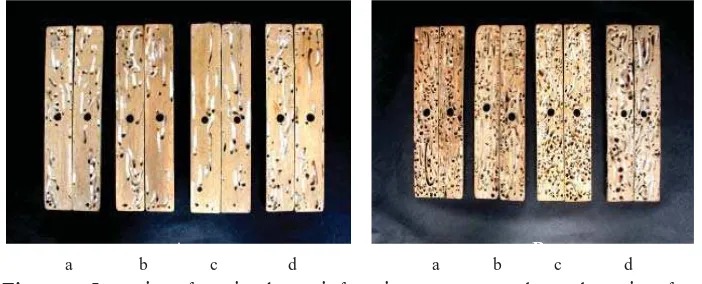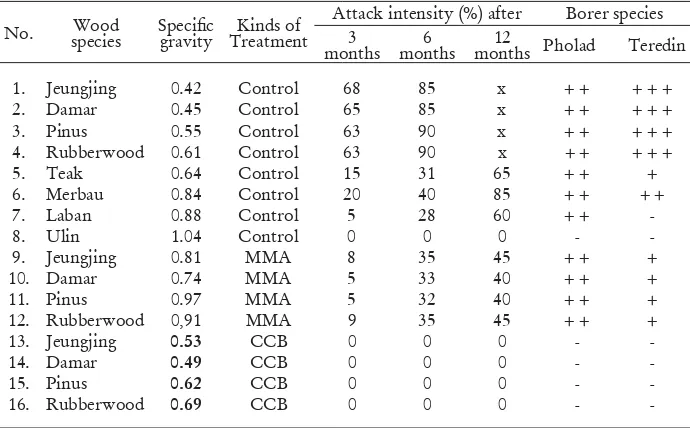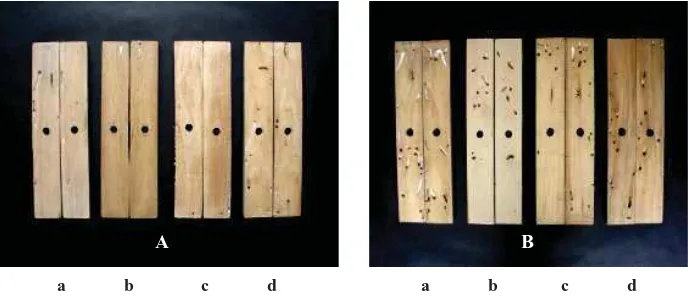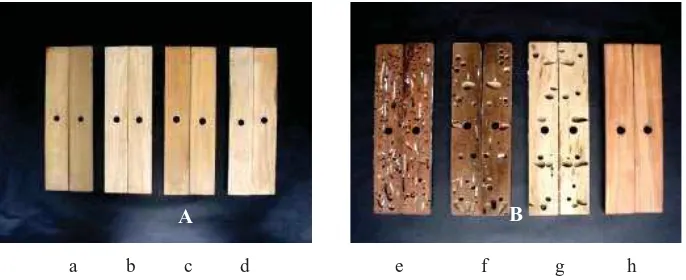CONSTRUCTION
Mohammad Muslich1,2 and Nurwati Hadjib1
ABSTRACT
Recently, timber estate or plantation forest plays an important role on wooden based industries. However, the plantation timber quality is relatively low. Some treatments have been developed to improve its low quality, such as preservation with CCB (Chromate Copper Boron) and impregnation with plastic compounds. This study is to compare the durability of timber treated with plastic and CCB, non-treated from plantation forest timber as well as from natural forest. The plantation timber studied were jeungjing (Paraserianthes falcataria), damar (Agathis sp.), pinus (Pinus merkusii), and rubberwood (Hevea brasilliensis). Non-treated timbers that usually used for marine construction were ulin (Eusideroxylon zwageri), jati/teak (Tectona grandis), laban (Vitex pubescens) and merbau (Instia bijuga). After 6 and 12 months, the results showed that CCB preserved timber were more durable than plastic impregnated timber and non-treated timber. Wood samples were mostly attacked by marine borer organisms from the family of Pholadidae and Teredinidae. The experiment results revealed the possibility of using those plantation forest timber species for marine construction purposes.
Keywords : Chromate Copper Boron, durability, marine wood
I. INTRODUCTION
Woods used for shipbuilding, pier poles and beach housing, usually suffer from marine borer attack. Two common organisms of marine borer are Mollusca and Crustacea. The molluscan borers are bivalves distantly related to clams and oysters, the most important of which are Teredo, Bankia and Martesia. Teredo and Bankia are collectively called “teredine borers”, or more commonly “shipworms”. Their appearance are similar. The bodies are soft, elongated, and worm-like (hence called shipworms). At the head end is a pair of roughly globular boring shells with a rasp or Þ le-like roughening used for burrowing. As boring progresses, this roughening is continually changed. At the tail end are two hard-feather or oar-shaped structures called “pallets” which protect a pair of “siphon tube”. The structures of the “pallets” help in the identiÞ cation of species (Turner, 1966).
Martesia is the genus found in our coastal waters. It is a typical bivalve shell with the body enclosed within the shells. It resembles a clam in general appearance and is pear-shaped, the tail end being slender. The shell seldom exceeds 1.5 inches in length but may attain a diameter of 0.75 inch. As in the case of shipworms, the young Martesia is a free-swimming organism that enters the wood through a small entrance hole. The burrow is the size, shape, and length of the shell and is nearly always at right-angled to the surface, and so, usually across the grain of wood (Mata and Siriban, 1972).
The wood-boring crustaceans are equipped with several pair of jointed legs, and are distantly related to the crab and wood louse. The borers of economic importance in this class are Limnoria, Chelura, and Sphaeroma. Limnoria or so-called “griblle” causes more damage to timbers than any other crustacean. These crustaceans are most active between tidemarks. Small bores are made on the surface of the piling and when great numbers of them are present, the burrows are separated by very thin walls of wood that are easily eroded by the motion of the water or objects ß oating upon it (Turner, 1966).
Marine constructions usually use high quality woods such as ulin (Eusideroxylon zwageri T.et B.), laban (Vitex pubescens Vahl.), teak (Tectona grandis L.f.), and merbau (Intsia bijuga O.Ktze.). The demand of such high quality wood tends to increase, while its supply is limited. To meet this need for marine construction wood with high quality has possibility to used plantation-forest or timber-estate woods as substitute. The advantage of timber estate wood is to reduce exploitation on the natural forest, and for economic regional aspect, it would absorb employment. Jeungjing, pine, damar and rubberwood are fast growing plantation-forest species that are planted in Indonesia, having durability class V against marine borers (Muslich and Sumarni, 2005). They are not resistant against marine borer’s attack. The application of preservation or chemical modiÞ cation can improve the wood durability.
II. MATERIALS AND METHODS
The woods used for this study were jeungjing (Paraserianthes falcataria Niel.), damar (Agathis sp.), pinus (Pinus merkusii Jungh. et de Vries), rubberwood (Hevea brasilliensis), teak (Tectona grandis L.f.), merbau (Instia biyuga O.Ktze.), laban (Vitex pubescens, Vahl.) and ulin (Eusideroxylon zwageri T.et B.).
pinus, and rubberwood) was polymerized with methyl metacrylate (MMA), and then irradiated with gamma 60Co at a rate of 40 kGy..
The test on marine borer attack was conducted in the waters of Rambut Island. The procedure for observation were as follows:
1. Each timber estate species was differentiated in 3 groups based on three durations or periods of marine borer attacks i.e. 3 months, 6 months, and 12 months.
2. At the end of observation periods, inspection on marine borer attacks was carried out by splitting up the samples.
3. Attack intensity could be determined using classiÞ cation on wood resistance to marine borers (Muslich and Sumarni, 2005).
4. Kinds of attacking marine borers organisms could be identiÞ ed using the marine borer classiÞ cation by Turner (1971).
III. RESULTS AND DISCUSSION
The experiment revealed that there were different intensities of marine borer attacked depending on the duration of sample exposure to sea waters. Most of the untreated samples were severely attacked by the marine borers after 3-month exposure, particularly jeungjing, damar, pinus, and rubberwood. Light attack on control wood species was frequently found on merbau, teak, and laban after 6 months, while ulin was resistant for 12 months (Figure 1 and Table 1).
a b c d a b c d
A B
Table 1. The intensity of marine borer infestation on test wood pieces
No. speciesWood SpecigravityÞ c TreatmentKinds of
Attack intensity (%) after Borer species 3
months months6 months Pholad12 Teredin
1. Jeungjing 0.42 Control 68 85 x ++ +++
Remarks: MMA = methyl methacrylate; CCB = chromated copper boron; x = completely destroyed; - = none; + = slight; ++ = moderate; +++ = heavy
showed that those marine borers belong to species of Teredo bartschi Clapp. and Bankia cieba Clench. Teredinidae damages wood by using it as food resource, so that the attack of the test wood samples reached the interior part. Turner (1966) stated that the genus Teredo possessed celullase enzyme, so that the cellulose in the wood could be degraded into easily digested food. Teredinidae grows faster in wood species which contain high cellulose and low silica content, low hardness and exhibit soft texture.
Table 1 also shows that all MMA (plastic) polymerized woods (jeungjing, damar, pinus, and rubberwood) were resistant until 6 months. The increase in resistance capacity of all the plastic wood was caused by changes in wood chemical properties. Particularly, the changes in cellulose and lignin on modiÞ cation due to wood polymerization with MMA. This condition is unfavorable for marine borers which require cellulose as their food. In addition, the hardness of plastic wood is greater than its compounding original wood (Figure 1, Table 2 and Table 3). This is one factor that supports an increase in wood resistance capacity against organism attack. This Þ nding is reconÞ rmed by Clouston (1968) who stated that plastic wood usually exhibits higher physical and mechanical properties. Further, Kent et al. (1963) stated that plastic wood will be also more resistant against weather and the attack by destroying insects.
a b c d a b c d
A B
Table 2. Physical properties of wood polymerized with methyl metacrylate Control MMA Control MMA Control MMA Control MMA
Pinus 0.44 0.97 30 8.87 96.66 13.77 7.63 3.27
Rubberwood 0.63 0.91 12.01 8.44 40.35 13.63 7.48 6.17 Jeungjing 0.42 0.81 46.94 6.55 34.12 6.66 6.69 3.75
Damar 0.45 0.74 - - - - 8.55 7.41
Table 3. Mechanical properties of wood polymerized with methyl metacrylate (MMA)
Control MMA Control MMA Control MMA Control MMA
Pinus 76,153 172,847 598 1608 286 722.8 393.3 484.0 Rubberwood 117,912 125,470 1060 1350 471 942.5 488.9 486.5 Jeungjing 77,945 108,544 468 741 147 155.0 192.4 250.6 Damar 143,000 151,000 618 881 130 462.0 288.0 403.0
a b c d e f g h
A B
Figure 3. Intensity of marine borer infestation on CCB-treated wood (A) and untreated wood (B) after twelve months exposure in the sea. Remarks: a. jeungjing, b. damar, c. pinus, d. rubberwood, e. merbau, f. teak, g. laban, h. ulin
Table 1 shows, that most of CCB-preserved specimens, were resistant until 12 months exposed in sea water. Wood species with low extractive or silica content were readily attacked by marine borers. However, those wood species were very permeable to liquid substances eventhough they were already dried. This means that they were easily impregnated with preservative solutions. It is fortunate that wood species with low extractive are permeable to liquids. Part of the timber is vulnerable is nevertheless easily preserved (Table 4).
Table 4. Retention (kg/m3) and penetration (%) of Chromated Copper Boron
(CCB) in particularwood species
Wood species Retention (kg/m3) Penetration(%) Treatability class
Pinus 50.75 100 A (easy)
Rubberwood 30.25 70 A (easy)
Jeungjing 35.45 90 A (easy)
Damar 28.50 85 A (easy)
who proved that teruntum (Lumnitzera littorea Voight.) wood and bungur (Langerstromia specisa Pers.) wood were resistant to marine borer attack although they did not contain silica.
IV. CONCLUSION
The untreated wood species of jeungjing, damar, pinus, and rubberwood were totally damaged at the third month of the experiment, while all the corresponding species treated wood plastic (MMA) survived until sixth months, and treated with CCB were resistant until 12 months. Light attack was frequently found in the control wood species, i.e. merbau, teak, and laban which were resistant for 6 months. Meanwhile, ulin was resistant for 12 months. The attacking marine borers were Martesia striata Linne. of Pholadidae family, Teredo bartschi Clapp., Dicyathifer manni Wright., and Bankia cieba Clench. of Teredinidae family. While all plastic woods survived until the sixth months, and all CCB preserved specimens resistant until 12 months.
REFERENCES
Bianchi, A.T.J. 1933. The resistance of some Netherlands East Indian timbers against the attack of shipworms (Teredo). Fifth Congress. Canada. pp. 3903 – 3906.
Clouston, J.G. 1968. Status and technology of polymer – containing Þ brous materials. Proceedings. Panel Bangkok. IAEA, Vienna.
Gongrijp, J.W. 1932. Gegevends battrefende een onderzoek naar Nederlandesch Indische Houtsorten, Welke Tegen de Faal worm Bestand Zijn. Mededeelingen Van Het Bosbouwproefstation. No. 25 Bogor. pp 1- 99. Kent, J.A., A.Wiston, W. Boyle and I. Updyke. 1963. Manufacture of
wood-plastic combination by use gamma radiation. Industrial User of Large Radiation Source. Vol. Proceedings of Conf. Salzburg, 1963. IAEA, Vienna.
Mata, P.G. and F.R. Siriban. 1972. Resistance of wood to marine borers. Technical Note, No.171. FORPRIDECOME, College, Laguna 3720. Manila.
Southwell, C.R. and J.D. Bultman. 1971. Marine borers resistance of untreated woods over long periods of immersion in tropical waters. Biotropica 3: 81-107. Naval Research Laboratory, Washington D.C.
Turner, R.D. 1966. A Survey and Illustrated Catalogue of Teredinidae. Museum of Comparative Zoology. Harvard University, Cambridge, Mass.
Turner, R.D. 1971. IdentiÞ cation on marine wood-boring mollusca. In: E.B.G. Jones and S.K. Eltringham (Eds.) Marine Borers, Fungi and Molding Organism of Wood., QECD, Paris. pp. 1-56.




